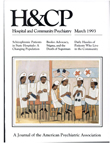Initial Evaluation of Reorganized Hospitalization Services in a Community Mental Health Center
Abstract
Objective: Two locked inpatient units at an inner-city community mental health center were reorganized as a hospitalization service consisting of a 22-bed intensive care inpatient unit, an acutetreatment day hospital for 20 patients, and a 23-bed transitional residence program. Levels of functioning of hospitalized patients treated before and after the reorganization were compared to determine if the reorganized program as a whole was more effective clinically than the two inpatient units had been. Methods: The authors retrospectively compared levels of functioning at discharge of random samples of 10 percent of patients treated in the ten months before the reorganization (N=66) and 10 percent of the intensive care and day hospital patients treated in the same ten calendar months afterward (N=78). They also compared data on episodes of seclusion and restraint and on patient flow in the two time periods. Results: The mean functional level of intensive care and day hospital patients treated in the reorganized service was significantly higher than the level of inpatients treated before. The mean duration of episodes of seclusion, but not of restraint, decreased significantly. Total service admissions and readmissions increased from 493 to 603. Conclusions: The reorganized service encouraged patients to function at higher levels. However, such a program must be affiliated with a diversified and well-functioning outpatient service that can divert some potential inpatients to appropriate alternative treatments and help move patients out of the day hospital-residential program when they are stabilized.
Access content
To read the fulltext, please use one of the options below to sign in or purchase access.- Personal login
- Institutional Login
- Sign in via OpenAthens
- Register for access
-
Please login/register if you wish to pair your device and check access availability.
Not a subscriber?
PsychiatryOnline subscription options offer access to the DSM-5 library, books, journals, CME, and patient resources. This all-in-one virtual library provides psychiatrists and mental health professionals with key resources for diagnosis, treatment, research, and professional development.
Need more help? PsychiatryOnline Customer Service may be reached by emailing [email protected] or by calling 800-368-5777 (in the U.S.) or 703-907-7322 (outside the U.S.).



